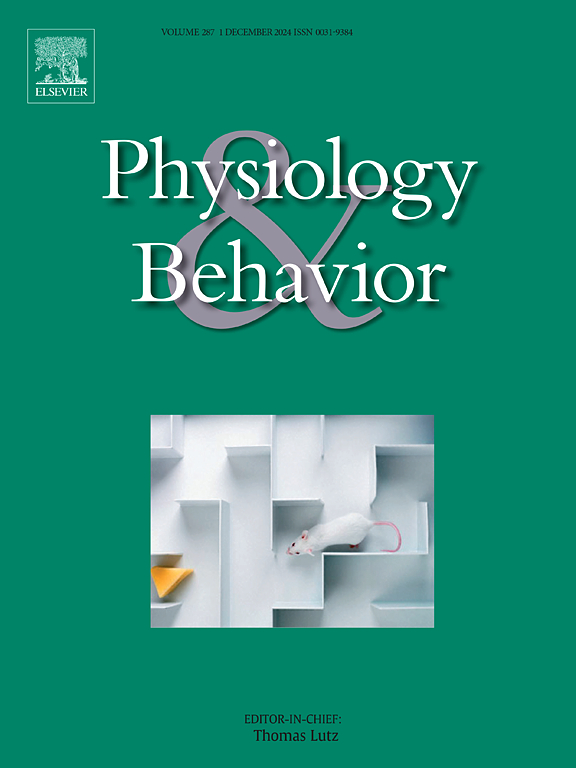Applicability of the micropipette-guided drug administration (MDA) method for assessing reward-related behaviors in mice
IF 2.4
3区 医学
Q2 BEHAVIORAL SCIENCES
引用次数: 0
Abstract
Oral gavage is the standard method for acute or chronic per os treatments in laboratory rodents. It can, however, induce significant stress responses and compromise the welfare of animals. To mitigate these concerns, we recently introduced the micropipette-guided drug administration (MDA) method, which utilizes a palatable vehicle (diluted sweetened condensed milk) for voluntary ingestion of drug solutions. While MDA minimizes stress and potential injury, the sugar content of the vehicle raises concerns about its possible influence on reward-related behaviors.. This study examined whether acute or chronic exposure to the MDA vehicle affects the performance of male and female C57BL/6 mice in three behavioral tests that are commonly used to assess reward-related functions, namely the novelty-suppressed eating, sucrose preference, and incentive runway tests. Compared to corresponding sham handling, neither acute nor chronic exposure to the MDA vehicle affected novelty-suppressed eating or sucrose preference in either sex. However, chronic but not acute exposure to the MDA vehicle influenced the animals’ performance in the incentive runway test, with a significant effect observed in male mice specifically. This sex-dependent outcome suggests that male mice may be more susceptible to changes in reward-seeking behavior after chronic exposure to the MDA vehicle. In conclusion, our findings support the suitability of the MDA method for studies utilizing the novelty-suppressed eating and sucrose preference tests, while highlighting the need for careful consideration when assessing reward-seeking behavior in male mice using the incentive runway test.
微管引导给药(MDA)方法评估小鼠奖励相关行为的适用性。
口服灌胃是实验室啮齿动物急性或慢性鼻窦炎治疗的标准方法。然而,它会引起严重的应激反应,损害动物的福利。为了减轻这些担忧,我们最近引入了微移管引导给药(MDA)方法,该方法利用一种可口的载体(稀释的甜炼乳)来自愿摄入药物溶液。虽然MDA能将应激和潜在伤害降至最低,但车辆的糖含量引起了人们对其对奖励相关行为的潜在影响的担忧。本研究考察了急性或慢性暴露于MDA是否会影响雄性和雌性C57BL/6小鼠在三种通常用于评估奖励相关功能的行为测试中的表现,即新奇性抑制进食、蔗糖偏好和激励跑道测试。与相应的假性处理相比,急性或慢性暴露于MDA载体均未影响性别的新颖性抑制饮食或蔗糖偏好。然而,慢性而非急性暴露于MDA载体会影响动物在激励跑道测试中的表现,特别是在雄性小鼠中观察到显著的影响。这一性别依赖性结果表明,在长期暴露于MDA载体后,雄性小鼠可能更容易发生寻求奖励行为的变化。总之,我们的研究结果支持MDA方法在利用新奇性抑制进食和蔗糖偏好测试的研究中的适用性,同时强调在使用激励跑道测试评估雄性小鼠的寻求奖励行为时需要仔细考虑。
本文章由计算机程序翻译,如有差异,请以英文原文为准。
求助全文
约1分钟内获得全文
求助全文
来源期刊

Physiology & Behavior
医学-行为科学
CiteScore
5.70
自引率
3.40%
发文量
274
审稿时长
47 days
期刊介绍:
Physiology & Behavior is aimed at the causal physiological mechanisms of behavior and its modulation by environmental factors. The journal invites original reports in the broad area of behavioral and cognitive neuroscience, in which at least one variable is physiological and the primary emphasis and theoretical context are behavioral. The range of subjects includes behavioral neuroendocrinology, psychoneuroimmunology, learning and memory, ingestion, social behavior, and studies related to the mechanisms of psychopathology. Contemporary reviews and theoretical articles are welcomed and the Editors invite such proposals from interested authors.
 求助内容:
求助内容: 应助结果提醒方式:
应助结果提醒方式:


